Electrochemical and Structural Characterization of Lanthanum-Doped Hydroxyapatite: A Promising Material for Sensing Applications
Abstract
1. Introduction
2. Materials and Methods
2.1. Synthesis
2.2. Screen-Printed Electrodes and Electrochemical Apparatus
2.3. Preparation of HAp Suspensions and HAp-Modified SPEs
2.4. Analytical Calculations
2.5. Scanning Electron Microscopy
2.6. Optical Microscopy/Raman spectroscopy
2.7. Infrared Spectroscopy
2.8. Powder X-ray Diffraction
3. Results and Discussion
3.1. Electrochemical Characterization
3.1.1. Electrochemical Characterization of HAp—Modified SPEs
3.1.2. Stability and Reusability of La-HAp Modified Platforms
3.2. Morphological Study
3.3. Structural Characterization
3.3.1. PXRD Qualitative Investigation
3.3.2. Structural Arrangement of La-Doped HAp
3.3.3. Vibrational Spectroscopy (FTIR, Raman)
4. Conclusions
Supplementary Materials
Author Contributions
Funding
Institutional Review Board Statement
Informed Consent Statement
Data Availability Statement
Acknowledgments
Conflicts of Interest
References
- Hughes, J.M.; Rakovan, J. The Crystal Structure of Apatite, Ca5(PO4)3(F,OH,Cl). Rev. Mineral. Geochem. 2002, 48, 1–12. [Google Scholar] [CrossRef]
- Ramesh, N.; Moratti, S.C.; Dias, G.J. Hydroxyapatite-Polymer Biocomposites for Bone Regeneration: A Review of Current Trends: Hydroxyapatite/polymer biocomposites for bone regeneration: A review. J. Biomed. Mater. Res. 2018, 106, 2046–2057. [Google Scholar] [CrossRef] [PubMed]
- Antoniac, I.V. Handbook of Bioceramics and Biocomposites; Springer: Berlin/Heidelberg, Germany; New York, NY, USA, 2016; ISBN 978-3-319-12459-9. [Google Scholar]
- Neacsu, I.A.; Stoica, A.E.; Vasile, B.S.; Andronescu, E. Luminescent Hydroxyapatite Doped with Rare Earth Elements for Biomedical Applications. Nanomaterials 2019, 9, 239. [Google Scholar] [CrossRef]
- Paterlini, V.; Bettinelli, M.; Rizzi, R.; El Khouri, A.; Rossi, M.; Della Ventura, G.; Capitelli, F. Characterization and Luminescence of Eu3+- and Gd3+-Doped Hydroxyapatite Ca10(PO4)6(OH)2. Crystals 2020, 10, 806. [Google Scholar] [CrossRef]
- Sari, M.; Hening, P.; Chotimah; Ana, I.D.; Yusuf, Y. Bioceramic Hydroxyapatite-Based Scaffold with a Porous Structure Using Honeycomb as a Natural Polymeric Porogen for Bone Tissue Engineering. Biomater. Res. 2021, 25, 2. [Google Scholar] [CrossRef] [PubMed]
- Ielo, I.; Calabrese, G.; De Luca, G.; Conoci, S. Recent Advances in Hydroxyapatite-Based Biocomposites for Bone Tissue Regeneration in Orthopedics. Int. J. Mol. Sci. 2022, 23, 9721. [Google Scholar] [CrossRef]
- Baldassarre, F.; Altomare, A.; Mesto, E.; Lacalamita, M.; Dida, B.; Mele, A.; Bauer, E.M.; Puzone, M.; Tempesta, E.; Capelli, D.; et al. Structural Characterization of Low-Sr-Doped Hydroxyapatite Obtained by Solid-State Synthesis. Crystals 2023, 13, 117. [Google Scholar] [CrossRef]
- Campi, G.; Cristofaro, F.; Pani, G.; Fratini, M.; Pascucci, B.; Corsetto, P.A.; Weinhausen, B.; Cedola, A.; Rizzo, A.M.; Visai, L.; et al. Heterogeneous and Self-Organizing Mineralization of Bone Matrix Promoted by Hydroxyapatite Nanoparticles. Nanoscale 2017, 9, 17274–17283. [Google Scholar] [CrossRef]
- Cristofaro, F.; Pani, G.; Pascucci, B.; Mariani, A.; Balsamo, M.; Donati, A.; Mascetti, G.; Rea, G.; Rizzo, A.M.; Visai, L. The NATO Project: Nanoparticle-Based Countermeasures for Microgravity-Induced Osteoporosis. Sci. Rep. 2019, 9, 17141. [Google Scholar] [CrossRef]
- Montagna, G.; Pani, G.; Flinkman, D.; Cristofaro, F.; Pascucci, B.; Massimino, L.; Lamparelli, L.A.; Fassina, L.; James, P.; Coffey, E.; et al. Long-Term Osteogenic Differentiation of Human Bone Marrow Stromal Cells in Simulated Microgravity: Novel Proteins Sighted. Cell. Mol. Life Sci. 2022, 79, 536. [Google Scholar] [CrossRef]
- Lu, L.; Zhang, L.; Zhang, X.; Huan, S.; Shen, G.; Yu, R. A Novel Tyrosinase Biosensor Based on Hydroxyapatite–Chitosan Nanocomposite for the Detection of Phenolic Compounds. Anal. Chim. Acta 2010, 665, 146–151. [Google Scholar] [CrossRef] [PubMed]
- Li, J.; Kuang, D.; Feng, Y.; Zhang, F.; Liu, M. Glucose Biosensor Based on Glucose Oxidase Immobilized on a Nanofilm Composed of Mesoporous Hydroxyapatite, Titanium Dioxide, and Modified with Multi-Walled Carbon Nanotubes. Microchim. Acta 2012, 176, 73–80. [Google Scholar] [CrossRef]
- Vakili, S.N.; Rezayi, M.; Chahkandi, M.; Meshkat, Z.; Fani, M.; Moattari, A. A Novel Electrochemical DNA Biosensor Based on Hydroxyapatite Nanoparticles to Detect BK Polyomavirus in the Urine Samples of Transplant Patients. IEEE Sens. J. 2020, 20, 12088–12095. [Google Scholar] [CrossRef]
- Vladislavić, N.; Rončević, I.Š.; Buzuk, M.; Buljac, M.; Drventić, I. Electrochemical/Chemical Synthesis of Hydroxyapatite on Glassy Carbon Electrode for Electroanalytical Determination of Cysteine. J. Solid State Electrochem. 2021, 25, 841–857. [Google Scholar] [CrossRef]
- Taha, S.; Begum, S.; Narwade, V.N.; Halge, D.I.; Dadge, J.W.; Mahabole, M.P.; Khairnar, R.S.; Bogle, K.A. Development of alcohol sensor using TiO2-Hydroxyapatite nano-composites. Mater. Chem. Phys. 2020, 240, 122228. [Google Scholar] [CrossRef]
- Nishikawa, H.; Okumura, D.; Kusunoki, M.; Hontsu, S. Application of Hydroxyapatite Thin Film as a Biosensor. In Proceedings of the APS March Meeting, Baltimore, MD, USA, 13–17 March 2006; Available online: https://ui.adsabs.harvard.edu/abs/2006APS..MARV16011N/abstract (accessed on 19 June 2023).
- Kanchana, P.; Sekar, C. EDTA Assisted Synthesis of Hydroxyapatite Nanoparticles for Electrochemical Sensing of Uric Acid. Mater. Sci. Eng. C 2014, 42, 601–607. [Google Scholar] [CrossRef]
- Kanchana, P.; Lavanya, N.; Sekar, C. Development of Amperometric L-Tyrosine Sensor Based on Fe-Doped Hydroxyapatite Nanoparticles. Mater. Sci. Eng. C 2014, 35, 85–91. [Google Scholar] [CrossRef]
- Kanchana, P.; Sekar, C. Development of Electrochemical Folic Acid Sensor Based on Hydroxyapatite Nanoparticles. Spectrochim. Acta Part A Mol. Biomol. Spectrosc. 2015, 137, 58–65. [Google Scholar] [CrossRef]
- Kanchana, P.; Sudhan, N.; Anandhakumar, S.; Mathiyarasu, J.; Manisankar, P.; Sekar, C. Electrochemical Detection of Mercury Using Biosynthesized Hydroxyapatite Nanoparticles Modified Glassy Carbon Electrodes without Preconcentration. RSC Adv. 2015, 5, 68587–68594. [Google Scholar] [CrossRef]
- Kanchana, P.; Navaneethan, M.; Sekar, C. Fabrication of Ce Doped Hydroxyapatite Nanoparticles Based Non-Enzymatic Electrochemical Sensor for the Simultaneous Determination of Norepinephrine, Uric Acid and Tyrosine. Mater. Sci. Eng. B 2017, 226, 132–140. [Google Scholar] [CrossRef]
- Huang, H.; Zhu, J.-J. The Electrochemical Applications of Rare Earth-Based Nanomaterials. Analyst 2019, 144, 6789–6811. [Google Scholar] [CrossRef]
- Arkin, V.H.; Lakhera, M.; Manjubala, I.; Narendra Kumar, U. Solid State Synthesis and Characterization of Calcium Phosphate for Biomedical Application. Int. J. Chem. Tech Res. 2015, 8, 264–267. [Google Scholar]
- Cancelliere, R.; Albano, D.; Brugnoli, B.; Buonasera, K.; Leo, G.; Margonelli, A.; Rea, G. Electrochemical and Morphological Layer-by-Layer Characterization of Electrode Interfaces during a Label-Free Impedimetric Immunosensor Build-up: The Case of Ochratoxin A. Appl. Surf. Sci. 2021, 567, 150791. [Google Scholar] [CrossRef]
- Di Tinno, A.; Cancelliere, R.; Mantegazza, P.; Cataldo, A.; Paddubskaya, A.; Ferrigno, L.; Kuzhir, P.; Maksimenko, S.; Shuba, M.; Maffucci, A.; et al. Sensitive Detection of Industrial Pollutants Using Modified Electrochemical Platforms. Nanomaterials 2022, 12, 1779. [Google Scholar] [CrossRef]
- Altomare, A.; Cuocci, C.; Giacovazzo, C.; Moliterni, A.; Rizzi, R.; Corriero, N.; Falcicchio, A. EXPO2013: A Kit of Tools for Phasing Crystal Structures from Powder Data. J. Appl. Crystallogr. 2013, 46, 1231–1235. [Google Scholar] [CrossRef]
- Altomare, A.; Campi, G.; Cuocci, C.; Eriksson, L.; Giacovazzo, C.; Moliterni, A.; Rizzi, R.; Werner, P.-E. Advances in Powder Diffraction Pattern Indexing: N-TREOR09. J. Appl. Crystallogr. 2009, 42, 768–775. [Google Scholar] [CrossRef]
- Altomare, A.; Corriero, N.; Cuocci, C.; Falcicchio, A.; Moliterni, A.; Rizzi, R. QUALX2.0: A Qualitative Phase Analysis Software Using the Freely Available Database POW_COD. J. Appl. Crystallogr. 2015, 48, 598–603. [Google Scholar] [CrossRef]
- PDF-2 ICDD. The Powder Diffraction File; International Center for Diffraction Data: Newton Square, PA, USA, 2003; Available online: https://www.icdd.com/pdf-2/ (accessed on 19 June 2023).
- Wieneke, J.U.; Kommoß, B.; Gaer, O.; Prykhodko, I.; Ulbricht, M. Systematic Investigation of Dispersions of Unmodified Inorganic Nanoparticles in Organic Solvents with Focus on the Hansen Solubility Parameters. Ind. Eng. Chem. Res. 2012, 51, 327–334. [Google Scholar] [CrossRef]
- Baldassarre, F.; Altomare, A.; Corriero, N.; Mesto, E.; Lacalamita, M.; Bruno, G.; Sacchetti, A.; Dida, B.; Karaj, D.; Ventura, G.D.; et al. Crystal Chemistry and Luminescence Properties of Eu-Doped Polycrystalline Hydroxyapatite Synthesized by Chemical Precipitation at Room Temperature. Crystals 2020, 10, 250. [Google Scholar] [CrossRef]
- Fleet, M.E.; Liu, X.; Pan, Y. Site Preference of Rare Earth Elements in Hydroxyapatite [Ca10(PO4)6(OH)2]. J. Solid State Chem. 2000, 149, 391–398. [Google Scholar] [CrossRef]
- Skorokhod, V.V.; Solonin, S.M.; Dubok, V.A.; Kolomiets, L.L.; Permyakova, T.V.; Shinkaruk, A.V.; Solonin, S.M.; Dubok, V.A.; Kolomiets, L.L.; Permyakova, T.V.; et al. Decomposition Activation of Hydroxyapatite in Contact with β-Tricalcium Phosphate. Powder Metall. Met. Ceram. 2010, 49, 324–329. [Google Scholar] [CrossRef]
- Landi, E.; Tampieri, A.; Celotti, G.; Sprio, S. Densification Behaviour and Mechanisms of Synthetic Hydroxyapatites. J. Eur. Ceram. Soc. 2000, 20, 2377–2387. [Google Scholar] [CrossRef]
- Garskaite, E.; Gross, K.-A.; Yang, S.-W.; Yang, T.C.-K.; Yang, J.-C.; Kareiva, A. Effect of Processing Conditions on the Crystallinity and Structure of Carbonated Calcium Hydroxyapatite (CHAp). CrystEngComm 2014, 16, 3950–3959. [Google Scholar] [CrossRef]
- Yashima, M.; Sakai, A.; Kamiyama, T.; Hoshikawa, A. Crystal Structure Analysis of β-Tricalcium Phosphate Ca3(PO4)2 by Neutron Powder Diffraction. J. Solid State Chem. 2003, 175, 272–277. [Google Scholar] [CrossRef]
- Dickens, B.; Schroeder, L.W.; Brown, W.E. Crystallographic Studies of the Role of Mg as a Stabilizing Impurity in β-Ca3(PO4)2. The Crystal Structure of Pureβ-Ca3(PO4)2. J. Solid State Chem. 1974, 10, 232–248. [Google Scholar] [CrossRef]
- Markgraf, S.A.; Reeder, R.J. High Temperature Structure Refinements of Calcite and Magnesite. Am. Mineral. 1985, 70, 590–600. [Google Scholar]
- Wilson, R.M.; Elliott, J.C.; Dowker, S.E.P. Rietveld Refinement of the Crystallographic Structure of Human Dental Enamel Apatites. Am. Mineral. 1999, 84, 1406–1414. [Google Scholar] [CrossRef]
- Okazaki, M.; Taira, M.; Takahashi, J. Rietveld Analysis and Fourier Maps of Hydroxyapatite. Biomaterials 1997, 18, 795–799. [Google Scholar] [CrossRef]
- Van Rees, H.B.; Mengeot, M.; Kostiner, E. Monoclinic-Hexagonal Transition in Hydroxyapatite and Deuterohydroxyapatite Single Crystals. Mater. Res. Bull. 1973, 8, 1307–1309. [Google Scholar] [CrossRef]
- Rossi, M.; Ghiara, M.R.; Chita, G.; Capitelli, F. Crystal-Chemical and Structural Characterization of Fluorapatites in Ejecta from Somma-Vesuvius Volcanic Complex. Am. Miner. 2011, 96, 1828–1837. [Google Scholar] [CrossRef]
- Brown, I.D.; Altermatt, D. Bond-Valence Parameters Obtained from a Systematic Analysis of the Inorganic Crystal Structure Database. Acta Crystallogr. B Struct. Sci. 1985, 41, 244–247. [Google Scholar] [CrossRef]
- Corbridge, D.E.C. The structural chemistry of phosphates. Bulmi 1971, 94, 271–299. [Google Scholar] [CrossRef]
- Angenault, J.; Couturier, J.C.; Souron, J.P.; Siliqi, D.; Quarton, M. The Martensitic Nature of the Transition Monoclinic ? Rhombohedral of LiSn2(PO4)3. J. Mater. Sci. Lett. 1992, 11, 1705–1707. [Google Scholar] [CrossRef]
- Giusti, L.; Landaeta, V.R.; Vanni, M.; Kelly, J.A.; Wolf, R.; Caporali, M. Coordination Chemistry of Elemental Phosphorus. Coord. Chem. Rev. 2021, 441, 213927. [Google Scholar] [CrossRef]
- Capitelli, F.; Rossi, M.; Elkhouri, A.; Elaatmani, M.; Corriero, N.; Sodo, A.; Della Ventura, G. Synthesis, Structural Model and Vibrational Spectroscopy of Lutetium Tricalcium Phosphate Ca9Lu(PO4)(7). J. Rare Earths 2018, 36, 1162–1168. [Google Scholar] [CrossRef]
- Altomare, A.; Rizzi, R.; Rossi, M.; El Khouri, A.; Elaatmani, M.; Paterlini, V.; Della Ventura, G.; Capitelli, F. New Ca2.90(Me2+)0.10(PO4)2 β-Tricalcium Phosphates with Me2+ = Mn, Ni, Cu: Synthesis, Crystal-Chemistry, and Luminescence Properties. Crystals 2019, 9, 288. [Google Scholar] [CrossRef]
- Inorganic Crystal Structure Database (ICSD); Version 2018-2; Fachinformationszentrum: Karlsruhe, Germany, 2018.
- Ursini, O.; Lilla, E.; Montanari, R. The Investigation on Cationic Exchange Capacity of Zeolites: The Use as Selective Ion Trappers in the Electrokinetic Soil Technique. J. Hazard. Mater. 2006, 137, 1079–1088. [Google Scholar] [CrossRef]
- Graeve, O.A.; Kanakala, R.; Madadi, A.; Williams, B.C.; Glass, K.C. Luminescence Variations in Hydroxyapatites Doped with Eu2+ and Eu3+ Ions. Biomaterials 2010, 31, 4259–4267. [Google Scholar] [CrossRef]
- Capitelli, F.; Khaoulaf, R.; Harcharras, M.; Ennaciri, A.; Habyby, S.H.; Valentini, V.; Mattei, G.; Bertolasi, V. Crystal Structure and Vibrational Spectroscopy of the New Acidic Diphosphate (NH4)2Zn(H2P2O7)2·2H2O. Z. Krist. 2009, 220, 25–30. [Google Scholar] [CrossRef]
- Cahil, A.; Najdoski, M.; Stefov, V. Infrared and Raman Spectra of Magnesium Ammonium Phosphate Hexahydrate (Struvite) and Its Isomorphous Analogues. IV. FTIR Spectra of Protiated and Partially Deuterated Nickel Ammonium Phosphate Hexahydrate and Nickel Potassium Phosphate Hexahydrate. J. Mol. Struct. 2007, 834–836, 408–413. [Google Scholar] [CrossRef]
- Campos, P.V.; Albuquerque, A.R.L.; Angélica, R.S.; Paz, S.P.A. FTIR Spectral Signatures of Amazon Inorganic Phosphates: Igneous, Weathering, and Biogenetic Origin. Spectrochim. Acta Part A Mol. Biomol. Spectrosc. 2021, 251, 119476. [Google Scholar] [CrossRef] [PubMed]
- Fowler, B.O. Infrared Studies of Apatites. I. Vibrational Assignments for Calcium, Strontium, and Barium Hydroxyapatites Utilizing Isotopic Substitution. Inorg. Chem. 1974, 13, 194–207. [Google Scholar] [CrossRef]
- Koutsopoulos, S. Synthesis and Characterization of Hydroxyapatite Crystals: A Review Study on the Analytical Methods. J. Biomed. Mater. Res. 2002, 62, 600–612. [Google Scholar] [CrossRef]
- Jastrzębski, W.; Sitarz, M.; Rokita, M.; Bułat, K. Infrared Spectroscopy of Different Phosphates Structures. Spectrochim. Acta Part A Mol. Biomol. Spectrosc. 2011, 79, 722–727. [Google Scholar] [CrossRef] [PubMed]
- Shaltout, A.A.; Allam, M.A.; Moharram, M.A. FTIR Spectroscopic, Thermal and XRD Characterization of Hydroxyapatite from New Natural Sources. Spectrochim. Acta Part A Mol. Biomol. Spectrosc. 2011, 83, 56–60. [Google Scholar] [CrossRef] [PubMed]
- Get’man, E.I.; Loboda, S.N.; Tkachenko, T.V.; Yablochkova, N.V.; Chebyshev, K.A. Isomorphous Substitution of Samarium and Gadolinium for Calcium in Hydroxyapatite Structure. Russ. J. Inorg. Chem. 2010, 55, 333–338. [Google Scholar] [CrossRef]
- Iconaru, S.-L.; Motelica-Heino, M.; Predoi, D. Study on Europium-Doped Hydroxyapatite Nanoparticles by Fourier Transform Infrared Spectroscopy and Their Antimicrobial Properties. J. Spectrosc. 2013, 2013, 284285. [Google Scholar] [CrossRef]
- Mayer, I.; Layani, J.D.; Givan, A.; Gaft, M.; Blanc, P. La Ions in Precipitated Hydroxyapatites. J. Inorg. Biochem. 1999, 73, 221–226. [Google Scholar] [CrossRef]
- Ahymah Joshy, M.I.; Elayaraja, K.; Suganthi, R.V.; Chandra Veerla, S.; Kalkura, S.N. In Vitro Sustained Release of Amoxicillin from Lanthanum Hydroxyapatite Nano Rods. Curr. Appl. Phys. 2011, 11, 1100–1106. [Google Scholar] [CrossRef]
- Jadalannagari, S.; Deshmukh, K.; Verma, A.K.; Kowshik, R.V.; Meenal Ramanan, S.R. Lanthanum-Doped Hydroxyapatite Nanoparticles as Biocompatible Fluorescent Probes for Cellular Internalization and Biolabeling. Sci. Adv. Mater. 2014, 6, 312–319. [Google Scholar] [CrossRef]
- Guo, D.G.; Wang, A.H.; Han, Y.; Xu, K.W. Characterization, Physicochemical Properties and Biocompatibility of La-Incorporated Apatites. Acta Biomater. 2009, 5, 3512–3523. [Google Scholar] [CrossRef] [PubMed]
- Serret, A.; Cabañas, M.V.; Vallet-Regí, M. Stabilization of Calcium Oxyapatites with Lanthanum(III)-Created Anionic Vacancies. Chem. Mater. 2000, 12, 3836–3841. [Google Scholar] [CrossRef]
- Ellis, D.E.; Terra, J.; Warschkow, O.; Jiang, M.; González, G.B.; Okasinski, J.S.; Bedzyk, M.J.; Rossi, A.M.; Eon, J.-G. A Theoretical and Experimental Study of Lead Substitution in Calcium Hydroxyapatite. Phys. Chem. Chem. Phys. 2006, 8, 967–976. [Google Scholar] [CrossRef]
- Timchenko, P.E.; Timchenko, E.V.; Pisareva, E.V.; Vlasov, M.Y.; Volova, L.T.; Frolov, O.O.; Kalimullina, A.R. Experimental studies of hydroxyapatite by Raman spectroscopy. J. Opt. Technol. 2018, 85, 130–135. [Google Scholar] [CrossRef]
- Kazin, P.E.; Pogosova, M.A.; Trusov, L.A.; Kolesnik, I.V.; Magdysyuk, O.V.; Dinnebier, R.E. Crystal Structure Details of La- and Bi-Substituted Hydroxyapatites: Evidence for LaO+ and BiO+ with a Very Short Metal–Oxygen Bond. J. Solid State Chem. 2016, 237, 349–357. [Google Scholar] [CrossRef]
- El Khouri, A.; Zegzouti, A.; Elaatmani, M.; Capitelli, F. Bismuth-Substituted Hydroxyapatite Ceramics Synthesis: Morphological, Structural, Vibrational and Dielectric Properties. Inorg. Chem. Commun. 2019, 110, 107568. [Google Scholar] [CrossRef]
- Zavala-Sanchez, L.A.; Hirata, G.A.; Novitskaya, E.; Karandikar, K.; Herrera, M.; Graeve, O.A. Distribution of Eu2+ and Eu3+ Ions in Hydroxyapatite: A Cathodoluminescence and Raman Study. ACS Biomater. Sci. Eng. 2015, 1, 1306–1313. [Google Scholar] [CrossRef]
- Fau, A.; Beyssac, O.; Gauthier, M.; Panczer, G.; Gasnault, O.; Meslin, P.-Y.; Bernard, S.; Maurice, S.; Forni, O.; Boulliard, J.-C.; et al. Time-Resolved Raman and Luminescence Spectroscopy of Synthetic REE-Doped Hydroxylapatites and Natural Apatites. Am. Mineral. 2022, 107, 1341–1352. [Google Scholar] [CrossRef]
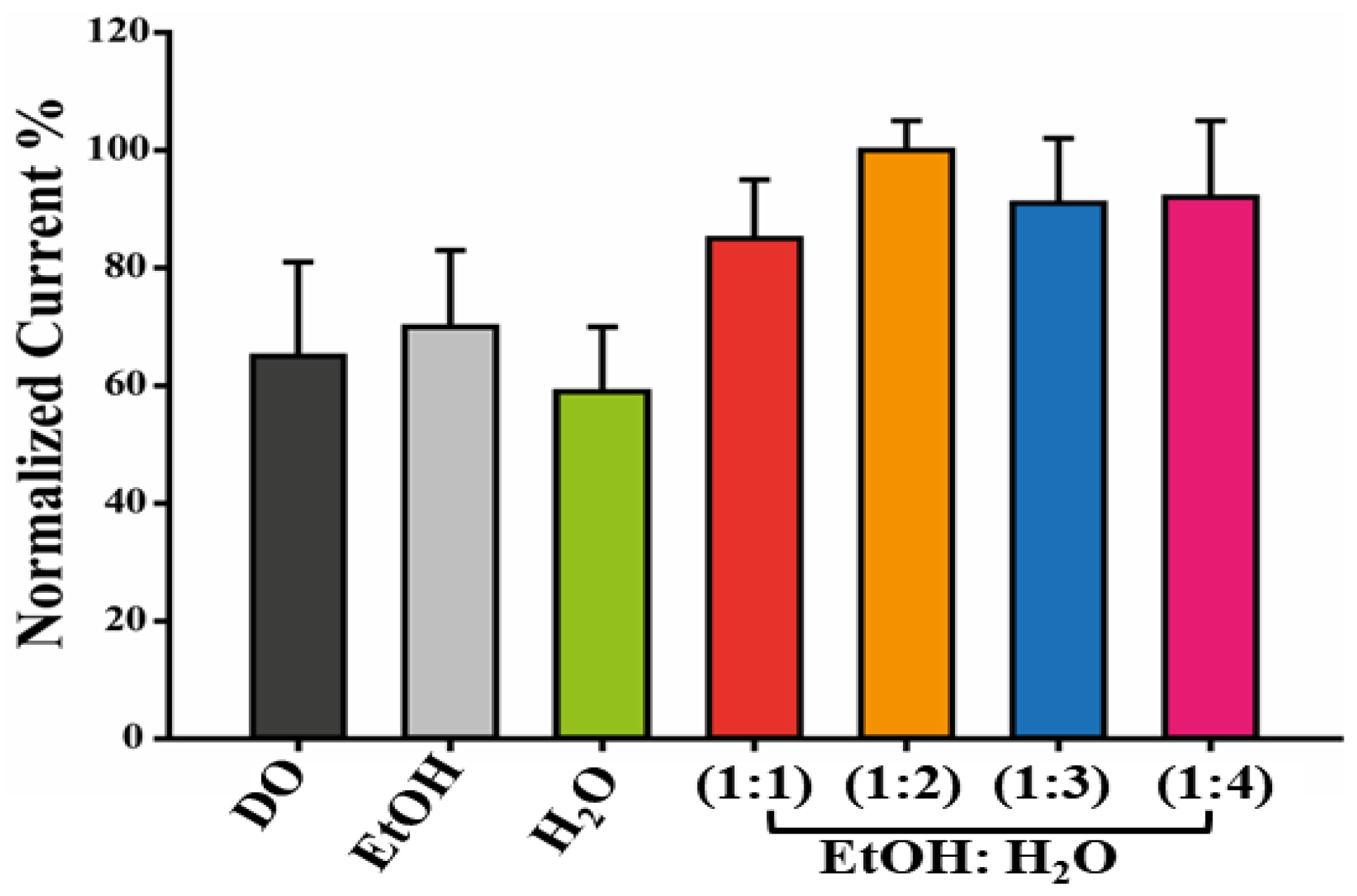


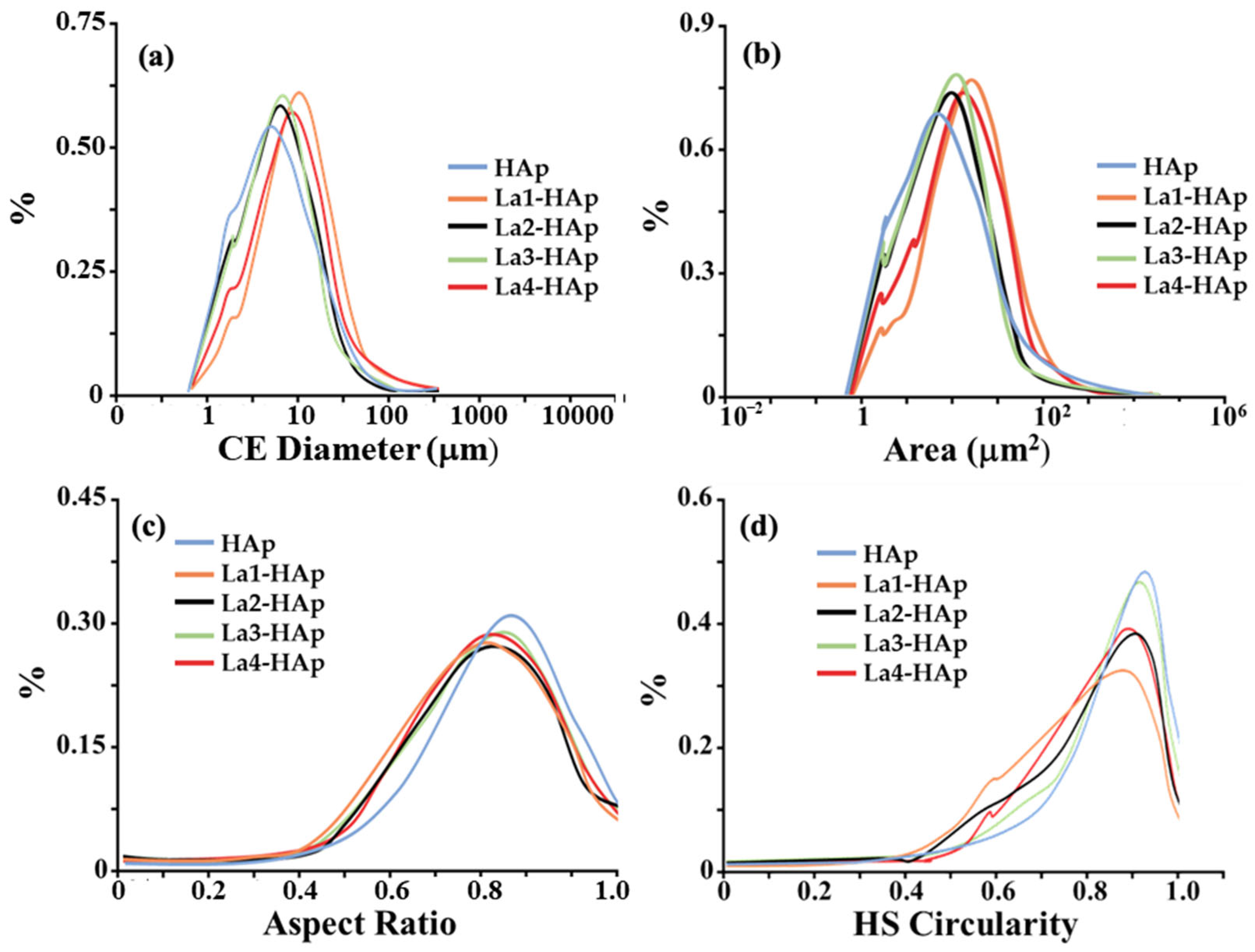
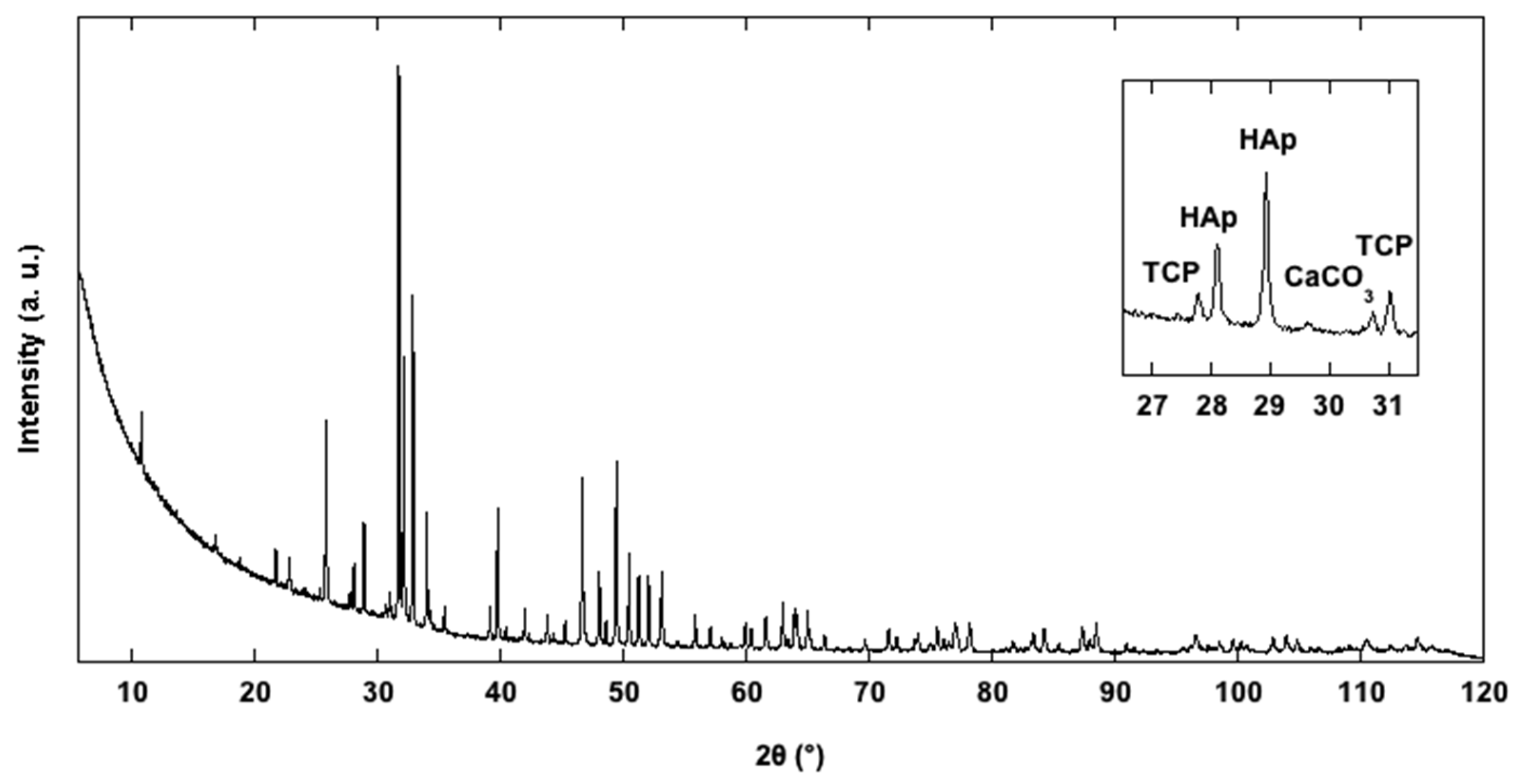

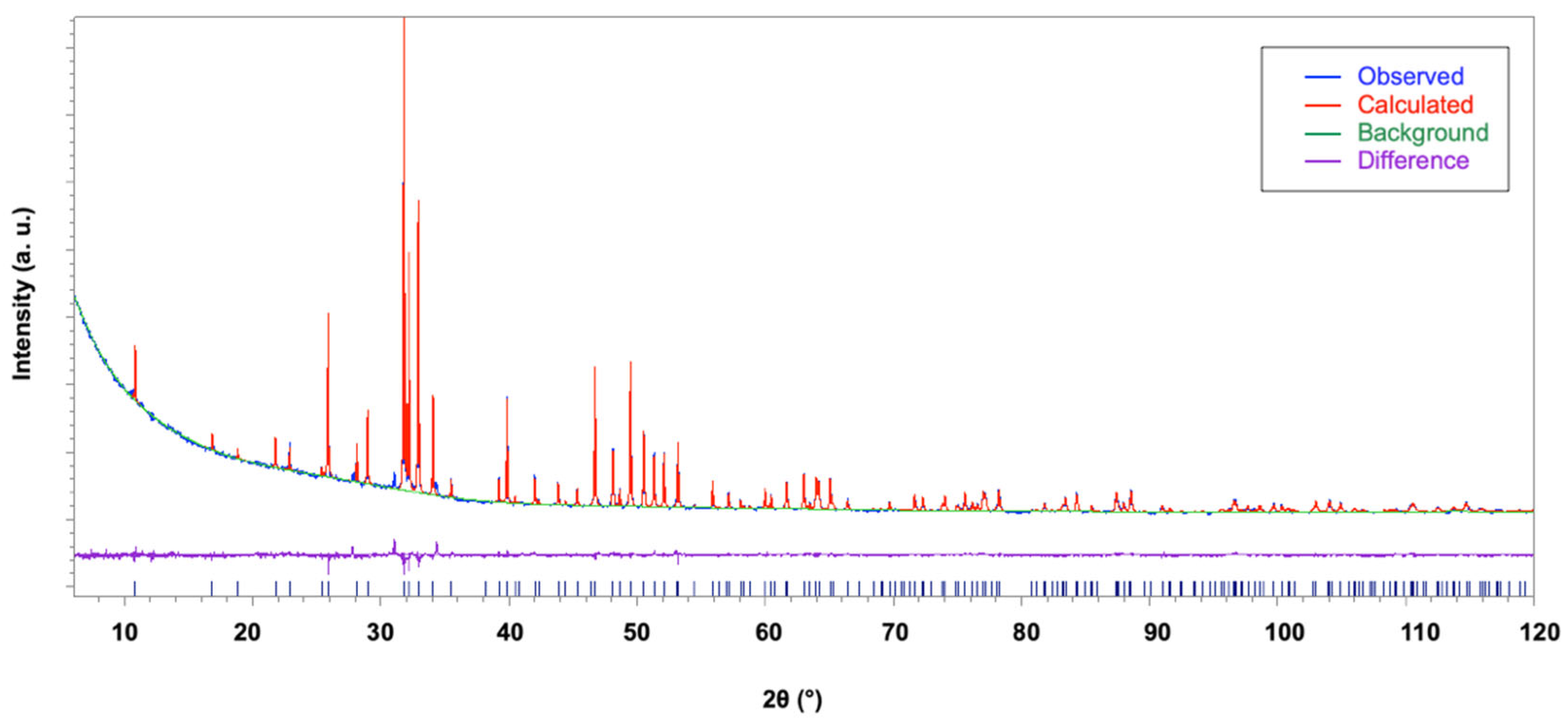

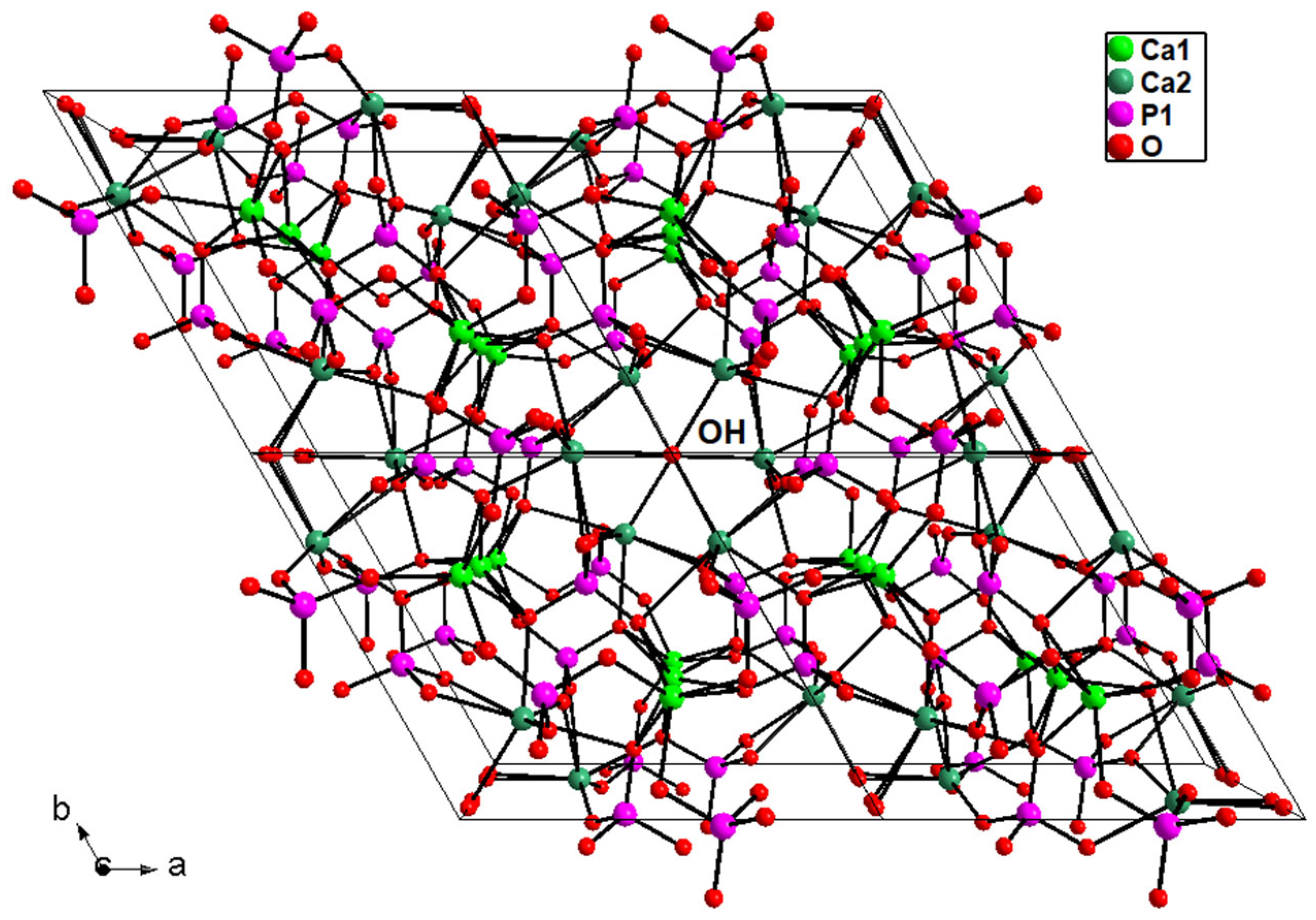
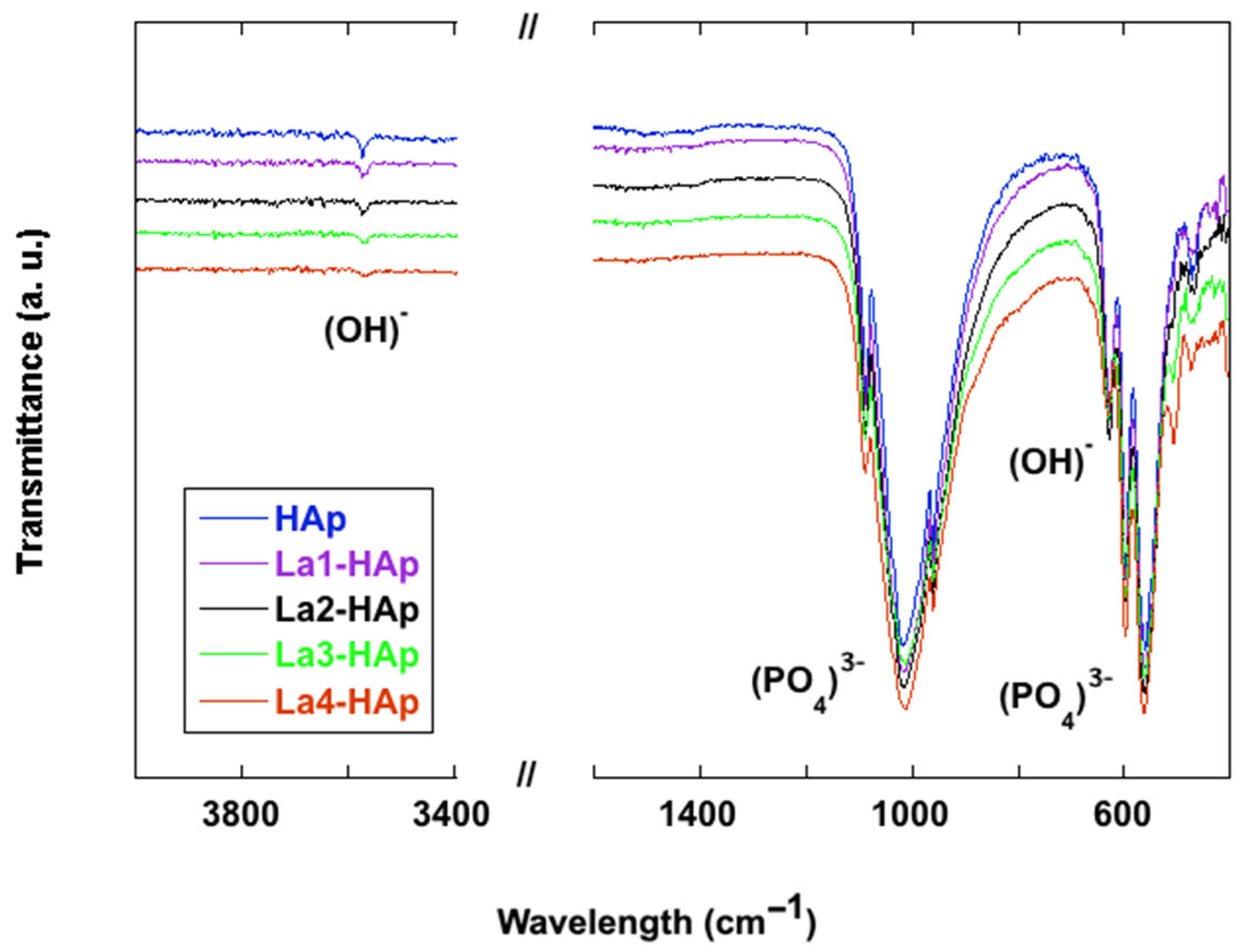

| La1-HAp | La2-HAp | La3-HAp | La4-HAp | |
|---|---|---|---|---|
| Nominal Lax Formula wt. | La0.01 1005.61 | La0.02 1008.10 | La0.10 1011.95 | La0.20 1031.30 |
| Color | Colorless | Colorless | Colorless | Colorless |
| T (K) | 293 | 293 | 293 | 293 |
| λ (Å) | 1.54056 | 1.54056 | 1.54056 | 1.54056 |
| 2θ; step (°) | 8–120, 0.02 | 8–120, 0.02 | 8–120, 0.02 | 6–120, 0.02 |
| Crystal system Space group | Hexagonal P63/m | Hexagonal P63/m | Hexagonal P63/m | Hexagonal P63/m |
| a = b (Å) | 9.4146(3) | 9.41472(13) | 9.41670(19) | 9.4194(3) |
| c (Å) | 6.8834(4) | 6.88333(18) | 6.8835(3) | 6.8853(3) |
| V (Å3) | 528.36(4) | 528.377(17) | 528.61(2) | 529.06(4) |
| Z; ρcalc. (Mg·m−3) | 1, 3.160 | 1, 3.168 | 1, 3.185 | 1, 3.237 |
| Refinement | FMLS | FMLS | FMLS | FMLS |
| Bragg refl. | 288 | 288 | 288 | 288 |
| Rp; Rwp; Rexp (%) | 4.21, 6.81; 6.07 | 2.21, 3.59, 4.73 | 2.54, 4.27, 4.91 | 4.75, 7.63, 5.43 |
| Sample | ΔRct (Ω) | ΔE (V) | Ipa/Ipc | % Increase in the Signal | |
|---|---|---|---|---|---|
| Rct | Current | ||||
| La1-HAp | −640 ± 54 | 0.55 ± 0.02 | 1.07 ± 0.1 | 63 | 55 |
| La2-HAp | −868 ± 26 | 0.36 ± 0.08 | 1.01 ± 0.1 | 85 | 79 |
| La3-HAp | −727 ± 91 | 0.58 ± 0.03 | 1.07 ± 0.1 | 71 | 68 |
| La4-HAp | −1231 ± 65 | 0.35 ± 0.02 | 1.01 ± 0.1 | 121 | 145 |
| Nd1-HAp | −1583 ± 250 | 0.32 ± 0.01 | 1.03 ± 0.1 | 155 | 123 |
| Nd2-HAp | −1256 ± 280 | 0.31 ± 0.02 | 1.06 ± 0.1 | 123 | 56 |
| Nd3-HAp | −1516 ± 320 | 0.30 ± 0.01 | 1.02 ± 0.1 | 149 | 88 |
| Nd4-HAp | −1127 ± 298 | 0.30 ± 0.04 | 1.06 ± 0.1 | 111 | 97 |
| Sm1-HAp | −1041 ± 71 | 0.31 ± 0.02 | 1.02 ± 0.1 | 102 | 111 |
| Sm2-HAp | −605 ±88 | 0.59 ± 0.03 | 1.08 ± 0.1 | 59 | 43 |
| Sm3-HAp | −1028 ± 51 | 0.29 ± 0.01 | 1.01 ±0.1 | 101 | 131 |
| Sm4-HAp | −724 ± 100 | 0.61 ± 0.01 | 1.05 ± 0.1 | 71 | 56 |
| Dy1-HAp | 133 ± 21 | 0.38 ± 0.01 | 1.00 ± 0.1 | −13 | −21 |
| Dy2-HAp | 183 ±15 | 0.38 ± 0.02 | 1.00 ± 0.1 | −18 | −26 |
| Dy3-HAp | 269 ± 23 | 0.39 ± 0.01 | 1.01 ± 0.1 | −26 | −36 |
| Dy4-HAp | 164 ± 16 | 0.39 ± 0.01 | 0.99 ± 0.1 | −16 | −13 |
| Tm1-HAp | −970 ± 243 | 0.56 ± 0.04 | 1.04 ± 0.1 | 95 | 62 |
| Tm2-HAp | −1119 ± 321 | 0.65 ± 0.001 | 1.05 ± 0.1 | 110 | 76 |
| Tm3-HAp | −1245 ± 211 | 0.63 ± 0.04 | 1.07 ± 0.1 | 122 | 112 |
| Tm4-HAp | −868 ± 188 | 0.65 ± 0.01 | 1.05 ± 0.1 | 85 | 93 |
| Lu1-HAp | 138 ± 21 | 0.36 ± 0.01 | 1.00 ± 0.1 | −14 | −34 |
| Lu2-HAp | 291 ± 19 | 0.37 ± 0.01 | 1.01 ± 0.1 | −29 | −33 |
| Lu3-HAp | 289 ± 23 | 0.36 ± 0.01 | 1.02 ± 0.1 | −28 | −19 |
| Lu4-HAp | 357 ± 17 | 0.36 ± 0.01 | 1.03 ± 0.1 | −35 | −41 |
| Atom | Site | x | y | z |
|---|---|---|---|---|
| Ca1 | 4f | 0.6667 | 0.3333 | z |
| Ca2 | 6h | x | y | 0.2500 |
| P1 | 6h | x | y | 0.2500 |
| O1 | 6h | x | y | 0.2500 |
| O2 | 6h | x | y | 0.2500 |
| O3 | 12i | x | y | z |
| O4OH | 4e | 0 | 0 | z |
| Distance | La1-HAp | bvp | La2-HAp | bvp | La3-HAp | bvp | La4-HAp | bvp |
|---|---|---|---|---|---|---|---|---|
| 3xCa1-O1 | 2.409(11) | 0.30 | 2.412(4) | 0.30 | 2.406(6) | 0.31 | 2.405(7) | 0.31 |
| 3xCa1-O2 | 2.445(11) | 0.28 | 2.451(3) | 0.27 | 2.447(6) | 0.27 | 2.445(11) | 0.28 |
| 3xCa1-O3 | 2.810(9) | 0.10 | 2.834(3) | 0.10 | 2.846(6) | 0.10 | 2.832(7) | 0.10 |
| 2.04 | 2.01 | 2.04 | 2.07 | |||||
| Ca2-O1 | 2.683(16) | 0.14 | 2.683(5) | 0.14 | 2.691(9) | 0.15 | 2.675(11) | 0.18 |
| Ca2-O2 | 2.354(13) | 0.35 | 2.364(4) | 0.34 | 2.372(7) | 0.35 | 2.364(7) | 0.39 |
| 2xCa2-O3 | 2.329(8) | 0.38 | 2.335(3) | 0.37 | 2.338(4) | 0.39 | 2.336(7) | 0.42 |
| 2xCa2-O3 | 2.507(11) | 0.23 | 2.495(4) | 0.21 | 2.480(6) | 0.26 | 2.483(8) | 0.29 |
| Ca2-O4OH | 2.379(5) | 0.33 | 2.378(2) | 0.33 | 2.365(4) | 0.36 | 2.360(5) | 0.39 |
| 2.04 | 1.97 | 2.16 | 2.38 | |||||
| P1-O1 | 1.558(18) | 1.17 | 1.527(6) | 1.27 | 1.538(10) | 1.24 | 1.565(14) | 1.15 |
| P1-O2 | 1.541(13) | 1.23 | 1.547(4) | 1.21 | 1.559(7) | 1.17 | 1.559(11) | 1.17 |
| 2xP1-O3 | 1.546(8) | 1.21 | 1.543(3) | 1.22 | 1.547(5) | 1.21 | 1.552(7) | 1.19 |
| 4.82 | 4.92 | 4.83 | 4.70 |
| HAp | La1-HAp | La2-HAp | La3-HAp | La4-HAp | Assignment |
|---|---|---|---|---|---|
| 3572 | 3572 | 3572 | 3572 | 3572 | νs(OH) |
| 1086 | 1087 | 1087 | 1088 | 1088 | ν3(PO4)3− |
| 1047 | 1047 | 1047 | 1047 | 1048 | |
| 1018 | 1019 | 1019 | 1019 | 1019 | |
| 960 | 960 | 960 | 961 | 961 | ν1(PO4)3− |
| 627 | 628 | 628 | 629 | 630 | νl(OH) |
| 597 | 598 | 598 | 598 | 598 | |
| 562 | 562 | 562 | 562 | 562 | ν4(PO4)3− |
| - | 508 | 508 | 506 | 505 | RE-O |
| 472 | 472 | 474 | 474 | 474 | ν2(PO4)3− |
| HAp | La1-HAp | La2-Hap | La3-HAp | La4-HAp | Assignment |
|---|---|---|---|---|---|
| 430 | 432 | 432 | 432 | 432 | ν2(PO4)3− |
| 445 | 448 | 448 | 448 | 448 | |
| 580 | 581 | 581 | 580 | 581 | ν4(PO4)3− |
| 589 | 592 | 592 | 592 | 592 | |
| 606 | 608 | 609 | 608 | 608 | |
| 961 | 963 | 962 | 962 | 962 | ν1(PO4)3− |
| 1029 | 1030 | 1030 | 1030 | 1030 | ν3(PO4)3− |
| 1044 | 1048 | 1048 | 1048 | 1048 | |
| 1073 | 1077 | 1077 | 1077 | 1077 |
Disclaimer/Publisher’s Note: The statements, opinions and data contained in all publications are solely those of the individual author(s) and contributor(s) and not of MDPI and/or the editor(s). MDPI and/or the editor(s) disclaim responsibility for any injury to people or property resulting from any ideas, methods, instructions or products referred to in the content. |
© 2023 by the authors. Licensee MDPI, Basel, Switzerland. This article is an open access article distributed under the terms and conditions of the Creative Commons Attribution (CC BY) license (https://creativecommons.org/licenses/by/4.0/).
Share and Cite
Cancelliere, R.; Rea, G.; Micheli, L.; Mantegazza, P.; Bauer, E.M.; El Khouri, A.; Tempesta, E.; Altomare, A.; Capelli, D.; Capitelli, F. Electrochemical and Structural Characterization of Lanthanum-Doped Hydroxyapatite: A Promising Material for Sensing Applications. Materials 2023, 16, 4522. https://doi.org/10.3390/ma16134522
Cancelliere R, Rea G, Micheli L, Mantegazza P, Bauer EM, El Khouri A, Tempesta E, Altomare A, Capelli D, Capitelli F. Electrochemical and Structural Characterization of Lanthanum-Doped Hydroxyapatite: A Promising Material for Sensing Applications. Materials. 2023; 16(13):4522. https://doi.org/10.3390/ma16134522
Chicago/Turabian StyleCancelliere, Rocco, Giuseppina Rea, Laura Micheli, Pietro Mantegazza, Elvira Maria Bauer, Asmaa El Khouri, Emanuela Tempesta, Angela Altomare, Davide Capelli, and Francesco Capitelli. 2023. "Electrochemical and Structural Characterization of Lanthanum-Doped Hydroxyapatite: A Promising Material for Sensing Applications" Materials 16, no. 13: 4522. https://doi.org/10.3390/ma16134522
APA StyleCancelliere, R., Rea, G., Micheli, L., Mantegazza, P., Bauer, E. M., El Khouri, A., Tempesta, E., Altomare, A., Capelli, D., & Capitelli, F. (2023). Electrochemical and Structural Characterization of Lanthanum-Doped Hydroxyapatite: A Promising Material for Sensing Applications. Materials, 16(13), 4522. https://doi.org/10.3390/ma16134522











